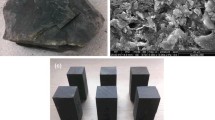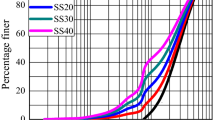Abstract
A number of cyclic triaxial tests were carried out on mine tailings and natural sediment samples under undrained conditions to investigate their resistance to cyclic loading. The tests were performed on more than 100 samples with a cyclic shear stress ratio ranging from 0.10 to 0.40 under varying void ratio and the same confining pressure. It was observed that the axial strain and excess pore water pressure increased with the number of loading cycles while the effective stress decreased with increasing number of loading cycles. The liquefaction resistance of the tailings was also observed to be higher than that of natural soils with similar particle size distribution, void ratio and plasticity index. It was observed that the influence of specific gravity on the cyclic strength of mine tailings is significant. The results showed that the cyclic resistance of the tailings was not strongly influenced by plasticity index for low plasticity tailings. A boundary relationship between void ratio and normalized cyclic resistance ratio was established based on the results.











Similar content being viewed by others
References
Alarcon-Guzman A, Leonards GA, Chameau JL (1988) Undrained monotonic and cyclic strength of sands. J Geotech Eng ASCE 114(10):1089–1109
Andrews DC, Martin GR (2000) Criteria for liquefaction of silty soils. In: Proceedings of the 12th world conference on earthquake engineering research, Auckland, New Zealand, 30 January–4 February 2000. New Zealand Society for Earthquake Engineering, Upper Hutt, New Zealand, pp 1–8. Paper 0312
ASTM Designation: D 2435 (1996) Standard test methods for one-dimensional consolidation properties of soils using incremental loading, annual book of ASTM standards. ASTM International, West Conshohocken
ASTM Designation: D 4767 (1996) Standard test methods for consolidated undrained triaxial compression test for cohesive soils, annual book of ASTM standards. ASTM International, West Conshohocken
ASTM Standard: D 5311-92 (1996) Test method for load controlled cyclic triaxial strength of soil, annual book of ASTM standards. ASTM International, West Conshohocken
Atukorala UD, Wijewickreme D, McCammon NR (2000) Some observations related to liquefaction susceptibility of silty soils. In: Proceedings of the 12th world conference on earthquake engineering, Auckland, New Zealand, 30 January–4 February 2000. New Zealand Society for Earthquake Engineering, Upper Hutt, New Zealand. Paper 1324
Bouckovalas GD, Andrianopoulos KI, Papadimitriou AG (2003) A critical state interpretation for the cyclic liquefaction resistance of silty sands. Soil Dyn Earthq Eng 23(2):115–125
Bouferra R, Benseddiq N, Shahrour I (2007) Saturation and preloading effects on the cyclic behavior of sand. Int J Geomech 7(5):396–401
Boulanger RW, Idriss IM (2006) Liquefaction susceptibility criteria for silts and clays. J Geotechn Geoenviron Eng 132(11):1413–1426
Boulanger RW, Idriss IM (2007) Evaluation of cyclic softening of silts and clays. J Geotechn Geoenviron Eng 133(6):641–652
Boulanger RW, Meyers MW, Mejia LH, Idriss IM (1998) Behavior of a fine-grained soil during the Loma Prieta earthquake. Can Geotech J 35(1):146–158
Braja MD (2002) Soil mechanics laboratory manual. Oxford university press, New York
Braja MD, Puri VK, Prakash S (1999) Liquefaction of silty soils. In: Pinto S (ed) Earthquake geotechnical engineering, Balkema, Rotterdam, pp 619–623
Bray JD, Sancio RB, Riemer MF, Durgunoglu T (2004) Liquefaction susceptibility of fine-grained soils. In: Proceedings of the 11th international conference on soil dynamics and earthquake engineering and third international conference on earthquake geotechnical engineering, Berkeley, CA, pp 655–62
Casagrande A (1976) Liquefaction and cyclic deformation of sands–a critical review, Harvard soil mechanics series no. 88. Harvard University, Cambridge
Castro G (1975) Liquefaction and cyclic mobility of saturated sands. J Geotech Eng Div ASCE 101(GT6):551–569
Cetin KO, Seed RB, Kiureghian AD, Tokimatsu K, Harder LF Jr, Kayen RE, Moss RES (2004) Standard penetration test-based probabilistic and deterministic assessment of seismic soil liquefaction potential. J Geotechn Geoenviron Eng 130(12):1314–1340
Finn WDL (1991) Assessment of liquefaction potential and post liquefaction behavior of earth structures: developments 1981–1991. In: Proceedings of second international conference on recent advances in geotechnical earthquake engineering and soil dynamics, St. Louis, vol 2, March 11–15, pp 1883–1850
Finn WDL (1993) Evaluation of liquefaction potential. In: Pinto S (ed) Soil dynamics and geotechnical earthquake engineering, Balkema, pp 127–157
Finn WDL, Pickering DJ, Bransby PL (1971) Sand liquefaction in triaxial and simple shear tests. J Soil Mechanics and Foundations Div ASCE 97(SM4):639–659
Finn WDL, Ledbetter RH, Wu G (1994) Liquefaction in silty soils: design and analysis. In: Prakash S, Dakoulas P (eds) Ground failures under seismic conditions. American Society of Civil Engineers, Geotechnical Special Publication 44, pp 51–76
Fourie AB, Blight GE, Papageorgiou G (2001) Soil liquefaction as a possible explanation for Merriespruit tailings dam failure. Can Geotech J 38(4):707–719
GeoNor AS (2005) Norwegian Geotechnical Institute (NGI) fall cone apparatus Model G-200. Instruction manual
Guo T, Prakash S (1999) Liquefaction of silts and silt-clay mixtures. J Geotech Geoenviron Eng ASCE 125(8):706–710
Hyde A, Higuchi T, Yasuhara K (2006) Liquefaction, cyclic mobility, and failure of silt. J Geotech Geoenviron Eng 132(6):716–735
ICOLD (2001) Tailings dams—risk of dangerous occurrences, lessons learnt from practical experiences, bulletin 121. United Nations Environmental Programme (UNEP) Division of Technology, Industry and Economics (DTIE) and International Commission on Large Dams (ICOLD), Paris, p 144
Idriss IM, Boulanger RW (2008) Soil liquefaction during earthquakes. Earthquake Engineering Research Institute, Oakland
Ishibashi I, Sherif M (1974) Soil liquefaction by torsional simple shear device. J Geotech Div ASCE 100(GT8):871–888
Ishihara K (1993) Liquefaction and flow failure during earthquakes. Geotechnique 43(3):351–415
Ishihara K, Troncoso J, Kawase Y, Takahashi Y (1980) Cyclic strength characteristics of tailings materials. Soils Found 20(4):127–142
Ishihara K, Yasuda S, Yokota K (1981) Cyclic strength of undisturbed mine tailings. In: Proceedings of the international conference on recent advances in geotechnical earthquake engineering and soil dynamics, vol 1. University of Missouri-Rolla, St. Louis, pp 53–58
James M, Gomes P, Schwenger R (2007) The liquefaction resistance of tailings and the stability of impoundments. In: Proceedings of the 60th Canadian geotechnical conference, Ottawa ON, Canada. (on CD-ROM). Canadian Geotechnical Society, Edmonton
Juang CH, Jiang T, Andrus RD (2002) Assessing probability-based methods for liquefaction potential evaluations. J Geotech Geoenviron Eng 128(7):580–589
Koester JP (1994) The influence of fines type and content on cyclic strength, ground failures under seismic conditions. ASCE Geotech Special Publ 44:17–33
Kramer L (1996) Geotechnical earthquake engineering. Prentice Hall, Englewood Cliffs
Leon E, Gassman SL, Talwani P (2006) Accounting for soil ageing when assessing liquefaction potential. J Geotech Geoenviron Eng 132(3):363–377
Marcuson WF III, Hynes ME, Franklin AG (1990) Evaluation and use of residual strength in seismic safety analysis of embankments. Earthq Spectra 6(3):529–572
McKee BE, Robinson KE, Urlich CM (1979) Upstream design for extension of an abandoned tailings pond. In: Argall GO (ed) Tailings disposal today: proceedings of the 2nd international tailings symposium, Denver, Colo., May 1978, vol 2. Miller Freeman Publications, San Francisco, pp 210–233
Moriwaki Y, Akky MR, Ebeling AM, Idriss IM, Ladd RS (1982) Cyclic strength and properties of tailings slimes. Dynamic stability of tailings dams. Preprint 82–539. American Society of Civil Engineers (ASCE), New York
Moss RES, Seed RB, Kayen RE, Stewart JP, Kiureghian AD, Cetin KO (2006) CPT-based probabilistic and deterministic assessment of in situ seismic soil liquefaction Potential. J Geotech Geoenviron Eng 132(8):1032–1051
Perlea VG (2000) Liquefaction of cohesive soils. In: Proceedings, soil dynamics and liquefaction. The Geo-Institute of the American Society of Civil Engineers, Denver, Colorado, pp 58–76
Perlea VG, Koester JP, Prakash S (1999) How liquefiable are cohesive soils? In: Proceedings of second international conference on earthquake geotechnical engineering, vol 2, Lisbon, Portugal, pp 611–618
Peters G, Verdugo R (2003) Seismic design considerations of tailings dams. In: Culligan PJ, Einstein HN, Whittle AJ (eds) Soil rock America 2003: proceedings of the 12th panamerican conference on soil mechanics and geotechnical engineering, vol 2, Massachusetts Institute of Technology, Cambridge, Mass, 22–26 June 2003. Verlag Gluckauf, Essen, Germany, pp 2241–2246
Polito CP, Martin JR (2001) Effect on non-plastic fines on the liquefaction resistance of sands. J Geotech Geoenviron Eng 127(5):408–415
Poulos SJ, Castro G, France JW (1985) Liquefaction evaluation procedure. J Geotech Eng ASCE 111(6):772–791
Prakash S (1981) Soil dynamics. McGraw-Hill, New York, p 1981
Prakash S, Puri VK (1982) Liquefaction of loessial soils. Third international earthquake microzontation conference, Seattle, June 28–July 1
Robertson PK (1994) Suggested terminology for liquefaction. In: Proceedings of the 47th Canadian geotechnical conference, Halifax, N.S. CGS. Sept, pp 277–286
Robertson PK, Wride CE (1998) Evaluating cyclic liquefaction potential using the cone penetration test. Can Geotech J 35(3):442–459
Sandoval JA (1989) Liquefaction and settlement characteristics of silt soils. PhD thesis. University of Missouri, Rolla, MO
Sanin MV, Wijewickreme D (2006) Cyclic shear response of channel-fill Fraser River Delta silt. Soil Dyn Earthq Eng 26:854–869
Seed HB (1979) Soil liquefaction and cyclic mobility evaluation for level ground during earthquakes. J Geotechnical Eng Div ASCE 105(GT2):201–255
Seed HB, Idriss IM (1971) Simplified procedure for evaluating soil liquefaction potential. J Soil Mech Found Div ASCE 97(9):1249–1273
Seed HB, Peacock WH (1971) Test procedures for measuring soil liquefaction characteristics. J Soil Mech Found Div ASCE 97(SM8):1099–1119 Proceeding paper 8330, August
Seed HB, Idriss IM, Arango I (1983) Evaluation of liquefaction potential using field performance data. J Geotech Eng ASCE 109(3):458–482
Sitharam TG, Govindaraju L, Sridharan A (2004) Dynamic properties and liquefaction potential of soils. Curr Sci 87:1370–1378
Sitharam TG, Anbazhagan P, Mahesh GU, Bharathi K, Nischala Reddy P (2005) Seismic hazard studies using geotechnical boerhole data and GIS. In: Proceedings of symposium on seismic hazard analysis and microzonation, Sep 2005, Roorkee
Thammathiwat A, Chim-oye W (2004) Behavior of strength and pore pressure of soft bangkok clay under cyclic loading. Thammasat Int J Sci Tech 9(4):21–25
Thevanayagam S, Fiorillo M, Liang J (2000) Effect of non-plastic fines on undrained cyclic strength of silty sands. Soil Dyn Liq ASCE 77–91
UNEP (1996) Environmental and safety incidents concerning tailings dams at mines: results of a survey for the years 1980–1996 by mining journal research services; a report prepared for United Nations Environment Programme, Industry and Environment. Paris, p 129
USACE (1980) Cyclic triaxial tests. EM 1110-2-1906 Change 1 (1 my 80)
USCOLD (1994) Tailings dam incidents, US Committee on Large Dams—USCOLD, Denver, Colorado, p 82. ISBN 1-884575-03-X, 1994
Vick SG (1983) Planning, design and analysis of tailings dams. Wiley series on geotechnical engineering. Wiley, New York
Wang W (1979) Some findings in soil liquefaction. Report Water Conservancy and Hydro-electric Power Scientific Research Institute, Beijing, China, pp 1–17
Wijewickreme D, Sanin MV (2004) Cyclic shear loading response of Fraser River Delta silt. In: Proceedings of the 13th world conference on earthquake engineering, Vancouver, BC, 1–6 August 2004. Canadian Association for Earthquake Engineering, c/o Department of Civil Engineering, University of Ottawa, Ottawa. Ont. Paper No. 499
Wijewickreme D, Sanin MV, Greenaway GR (2005) Cyclic shear response of fine-grained mine tailings. Can Geotech J 42:1408–1421
Wykeham Farrance (2008) Advanced cyclic triaxial testing system. Instruction manual. Soil Mechanics Division of Controls Group
Yamamuro JA, Lade PV (1998) Steady state concepts and static liquefaction of silty sands. J Geotech Geoenviron Eng ASCE 124(9):868–877
Youd TL, Idriss IM, Andrus RD, Arango I, Castro G, Christian JT, Dobry R, Finn WDL, Harder LF, Hynes ME, Ishihara K, Koester JP, Liao SSC, Marcuson WF III, Martin GR, Mitchell JK, Moriwaki Y, Power MS, Robertson PK, Seed RB, Stokow KH II (2001) Liquefaction resistance of soils: summary report from the 1996 NCEER and 1998 NCEER/NSF workshops on evaluation of liquefaction resistance of soils. J Geotech Geoenviron Eng 127(10):817–833
Zhu R and Law KT (1988) Liquefaction potential of silt. In: Proceedings of ninth world conference on earthquake engineering, vol III, August 2–9, Tokyo-Kyoto, Japan, pp 237–242
Acknowledgments
The work described in this paper was supported with funding from the Natural Sciences and Engineering Research Council of Canada (NSERC) under an Individual Discovery Grant awarded to Dr. E. K. Yanful.
Author information
Authors and Affiliations
Corresponding author
Rights and permissions
About this article
Cite this article
Geremew, A.M., Yanful, E.K. Laboratory Investigation of the Resistance of Tailings and Natural Sediments to Cyclic Loading. Geotech Geol Eng 30, 431–447 (2012). https://doi.org/10.1007/s10706-011-9478-x
Received:
Accepted:
Published:
Issue Date:
DOI: https://doi.org/10.1007/s10706-011-9478-x




